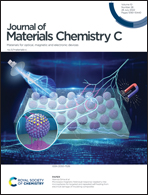Improved photovoltaic performance of quinoxaline-based polymers by systematic modulation of electron-withdrawing substituents†
Abstract
In this study, systematic structural modifications using electron-withdrawing substituents were carried out on quinoxaline-based donor–acceptor (D–A)-type polymers to achieve promising p-type polymers for photovoltaic applications. First, the polymer PB-FQxF, composed of electron-donating benzodithiophene (BDT) with two thienyl side chains and electron-accepting quinoxaline with multiple F atoms, was prepared as a reference. Afterward, two promising approaches for incorporating additional F atoms on the two thienyl groups on the BDT donor and replacing the F atom on the quinoxaline acceptor with a more electron-withdrawing CN moiety were methodically attempted to produce three target polymers, PBF-FQxF, PB-FQxCN, and PBF-FQxCN. Notably, the F atoms and CN units in the BDT donor and quinoxaline acceptor, respectively, can modulate the diverse properties of the polymers, leading to a positive impact on their photovoltaic properties. The performance of the PSCs was improved in the following sequence of PB-FQxF, PBF-FQxF, PB-FQxCN, and PBF-FQxCN by increasing the number and strength of the existing electron-withdrawing substituents. Owing to the mutual cooperative effects of the F atom and CN unit on the BDT donor and the CN unit on the quinoxaline acceptor, respectively, the device with PBF-QxCN exhibited the best power conversion efficiency of 12.11%.



 Please wait while we load your content...
Please wait while we load your content...